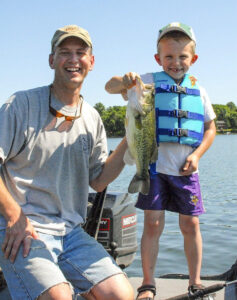By Dave Maas
As a father of two boys, ages 10 and 12, I know that every time we’re on the water as a family, the No. 1 goal is for them to catch fish and have a good time. My fishing is secondary. Below are 3 tips I’ve learned to ensure each of our fishing trips is a success.
Avoid The ER
During my many summers guiding and teaching fishing to kids and adults at a resort in northern Minnesota, my fellow guides used to have fun at my expense by saying to the guests, “Don’t get in Maas’ boat; he doesn’t allow treble hooks.” That statement is only partially true. If my boat partners could demonstrate safe casting, I’d let them fish with whatever lure they wanted, but until then, I had a single-hooks-only rule. Why? Because just as it’s easier to remove a single hook than a treble from a fish’s mouth, it’s easier to extract a single hook from a kid’s arm – or shoulder, scalp, back, etc.
And always obey the 90-degree rule. Everyone must face the same direction, and every cast is made at a right angle (90 degrees) to the center line of the boat. When I’ve seen someone hook another person on their back cast, it’s almost always because they tried to cheat the 90-degree rule and made a cast either ahead or behind the boat. Be strict in enforcing this rule because the quickest way to ruin a fun day of fishing is with a trip to the ER.
I insist that everyone in my boat wears sunglasses while casting. Buy several sunglasses and leave them in a rod locker so you’re always prepared. You can spend a small fortune on polarized fishing glasses, but you can buy Strike King Pro Series shades that do the job for about $20 each. I’ve never seen a hook buried in a person’s eye and hope I never will.
Action Is Everything
I can still remember a few times when I was guiding a father/son pair, and the dad insisted we target walleyes, even though the seasonal/weather conditions for catching them were poor. So instead of standing to cast spinnerbaits for northern pike or topwaters for largemouths, we sat in the boat and dragged live-bait rigs for sluggish deep-water walleyes.
I like to fish for anything, anywhere, but kids want action. They probably won’t be satisfied with one strike per hour, especially if that means trying to decipher whether a walleye has slurped a nightcrawler. When I have kids or novice anglers in the boat, I fish for whatever is biting best. Sunfish on spawning beds? Perfect. Rock bass near a beaver lodge? Outstanding. Largemouth bass in lily pads at sunset? Nothing better.
As young anglers become more skilled, you can modify your tactics and presentations. For example, if your kids are hammering bluegills or crappies on small jigs suspended below floats, after a while remove the float to see if they can feel a strike. Teach them what it means to watch their line to see a strike. Be patient. Be supportive. Remember – this is about them, not you.
Bass tip: Teach a child to catch deep-weedline bass on soft plastics, and their ability to put fish in the boat day in and day out will skyrocket. When I’m on a hot bite, I’m not too choosy about specific soft plastics because the fish aren’t choosy. But when fishing is tougher, every kid in my boat is using Berkley Power Worms to maximize their chances of feeling and seeing strikes. The slogan, “Fish bite and won’t let go!” is true.
First Water is Key
The term “back-boated” is a familiar one among bass anglers. It means the person in the front of the boat – running the trolling motor – is keeping all the good, new water to himself, while the angler on the rear casting platform suffers in no man’s land. This can be a fun prank to pull on a buddy, especially if you have a $5 bet riding on the biggest or most fish, but you shouldn’t do it to your kids. That said, each summer I see dads who – out of ignorance I hope – work a shoreline bow first, with the kids’ lures always playing second fiddle. Not good.
If you have to stand in the bow to operate the trolling motor, then put down your fishing rod and simply let the kids fish. Or, if you can play the wind correctly, slip your boat downwind along a shoreline – stern leading the way – so a child on the rear casting platform gets first water. You can cast to any fish they miss.
Another option for anglers who prefer an electric-steer trolling motor over a cable-steer model is to control the boat from the stern and have your child stand on the roomy front casting deck. Although I’m a cable-steer (front of the boat) guy, several of my buddies guide from the stern using a trolling motor remote with the Minn Kota i-Pilot system. Do whatever works best for your family.
This summer, enjoy your time on the water, and think about ways to keep your kids excited about fishing. You’ll know you’re on the right track when you’re placing rods in the locker at the end of the day and they’re begging, “Dad, just one more cast!”
















